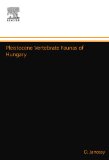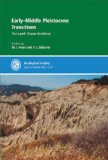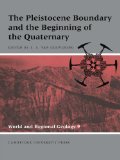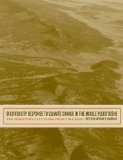Pleistocene
- A magnetostratigraphic time frame for Plio-Pleistocene transgressions in the South Caspian Basin, Azerbaijan

- A Pleistocene Bestiary
- A simple mixing explanation for late Pleistocene changes in the Pacific-South Atlantic benthic 13C gradient

- Calabrian and Ionian: A proposal for the definition of Mediterranean stages for the Lower and Middle Pleistocene

- Climato-chronostratigraphic framework of Pleistocene terrestrial and marine deposits of Northern Eurasia, based on pollen, electron spin resonance, and infrared optically stimulated luminescence analyses

- Contribution of changes in opal productivity and nutrient distribution in the coastal upwelling systems to Late Pliocene/Early Pleistocene climate cooling

- Cross-check of the dating results obtained by ESR and IR-OSL methods: implication for the Pleistocene palaeoenvironmental reconstructions

- Depositional environment and climate changes during the late Pleistocene as recorded by the Netiesos section in southern Lithuania

- Dynamics of Pleistocene Paleoclimatic Events: A Reconstruction Based on Palynological and Electron Spin Resonance Studies in North Eurasia

- Early Pleistocene climatic cycles in continental deposits of the Lesser Caucasus of Armenia inferred from palynology, magnetostratigraphy, and 40Ar/39Ar dating

- ES 331-767 Glossary of Ice Age Terms
- Explaining the Pleistocene megafaunal extinctions: Models, chronologies, and assumptions

- Field Trip To Pleistocene Lake Manix, Mojave Desert, California
- Fossils From Pleistocene Lake Manix, California
- Institute for Ice Age Studies
- Introducere in Pleistocene
- Late Pleistocene Extinctions
- Lower and middle pleistocene sediments of eastern Srem (northern Serbia) Paleogeographical reconstruction

- Middle Pleistocene site at Boxgrove
- Multi-proxy evidences of Mid-Pleistocene dry climates observed on calcretes in Central Turkey

- Patterns and processes in a Pleistocene fluvio-aeolian environment
- Pleistocene
- Pleistocene
- Pleistocene of Illinois
- Pleistocene Animals
- Pleistocene Epoch
- Pleistocene Epoch (The Columbia Encyclopedia Sixth Edition. 2000)
- Pleistocene Epoch
- Pleistocene Epoch
- Pleistocene Extinctions
- Pleistocene glacial variability as a chaotic response to obliquity forcing

- Pleistocene Glaciation
- Pleistocene Glaciations of the North Sea basin

- Pleistocene Holocene Transition
- Pleistocene Ice Age
- Pleistocene magnetochronology of the fauna and Paleolithic sites in the Nihewan Basin: Significance for environmental and hominin evolution in North China

- Plio-Pleistocene African climate

- Radiocarbon chronology of Late Pleistocene large mammal faunas from the Pannonian basin (Hungary)

- Stratigraphical and palaeogeographical characteristics of Pleistocene series in the Sava riparian area at Belgrade (Serbia)

- Structure, formation and geochronology of the late Pleistocene and Holocene cover deposits in South-Eastern Lithuania

- Synchronous extinction of North America’s Pleistocene mammals

Books about Pleistocene
| The Pleistocene: Geology and Life in the Quaternary Ice Age `...a wonderful book! ...a comprehensive treatment of the fauna, flora and formations of the last 2 million years. ...every serious library must have a copy.' Journal of Coastal Research, 1:4 (1985) `...an amazing book, in part because it has often been said in recent years that no single author these days could put together such a synthesis. ...an easy-to-read, well-written, amazingly thorough treatise on the Pleistocene. It is without equal among the current monographic works in terms of coverage, depth, and timeliness. ...Nilsson has captured the flavor of the history, development, and controversy of Quaternary science and provided us with an invaluable source book.' Arctic and Alpine Research, 17:3 |
|
| Pleistocene Vertebrate Faunas of Hungary The last two decades have seen a spectacular renewal of interest in the study of Pleistocene vertebrates. This is especially true in the case of fine stratigraphy based on microvertebrates. Hungary's natural endowments as well as the development of science in the country, have made continuous research in this area possible since the last century. The literature amassed during the last fifty years is so scattered and difficult to retrieve that there has been a great need for a comprehensive treatise in this field. Recent decades have seen work in a series of important new localities, with new systematic-stratigraphic results. This Hungarian work is outstanding in Europe for its quantity and completeness. It is clear that a handbook would have to be both comprehensive and analytical. This volume aims to be just that, in so far as it describes all animal assemblages of the Hungarian Pleistocene deposits, with complete faunistic lists and with detailed explanation of the stratigraphical arrangements. The value of this book is enhanced by a series of chronological tables for various localities, several sketches, pictures of localities, as well as indexes of localities and species. |
|
| Early Middle Pleistocene Transitions: The Land-Ocean Evidence The Early-Middle Pleistocene transition (around 1.2 to 0.5 Ma) marks a profound shift in Earth's climate state. Low-amplitude 41 ka climate cycles, dominating the earlier part of the Pleistocene, gave way progressively to a 100 ka rhythm of increased amplitude that characterizes our present glacial-interglacial world. This volume assesses the biotic and physical response to this transition both on land and in the oceans: indeed it examines the very nature of Quaternary climate change. Milankovitch theory, palaeoceanography using isotopes and microfossils, marine organic geochemistry, tephrochronology, the record of loess and soil deposition, terrestrial vegetational change, and the migration and evolution of hominins as well as other large and small mammals, are all considered. These themes combine to explore the very origins of our present biota. |
|
| The Pleistocene Boundary and the Beginning of the Quaternary The Pleistocene Boundary and the Beginning of the Quaternary presents the results of a forty-year international program to establish a precise definition for the most important boundary in geologic time - the beginning of the modern age of glacial climates. This book, the final report of International Geological Correlation Project 41, describes the selection of a fixed reference point in the sequence of deep-water marine strata exposed at Vrica, Italy. This point, dated to 1.81 million years before the present, coincides with the onset of the first of four major glacial phases. The opening chapters of the book document the geology and palaeontology of the agreed physical reference point, and the successful proposal of this point as the boundary-stratotype of the Pleistocene Epoch. The book then describes the correlation of the boundary throughout the ocean basins and continents of the world in terms of detailed stratigraphic criteria such as planktonic biostratigraphy, magnetostratigraphy and radiometric age determinations. |
|
| Biodiversity Response to Climate Change in the Middle Pleistocene: The Porcupine Cave Fauna from Colorado This book chronicles the discovery and analysis of animal fossils found in one of the most important paleontological sites in the world--Porcupine Cave, located at an elevation of 9,500 feet in the Colorado Rocky Mountains. With tens of thousands of identified specimens, this site has become the key source of information on the fauna of North America's higher elevations between approximately 1 million and 600,000 years ago, a period that saw the advance and retreat of glaciers numerous times. Until now, little has been understood about how this dramatic climate change affected life during the middle Pleistocene. In addition to presenting state-of-the-art data from Porcupine Cave, this study also presents groundbreaking analysis on what the data from the site show about the evolutionary and ecological adjustments that occurred in this period, shedding light on how one of the world's most pressing environmental concerns--global climate change--can influence life on earth. |




